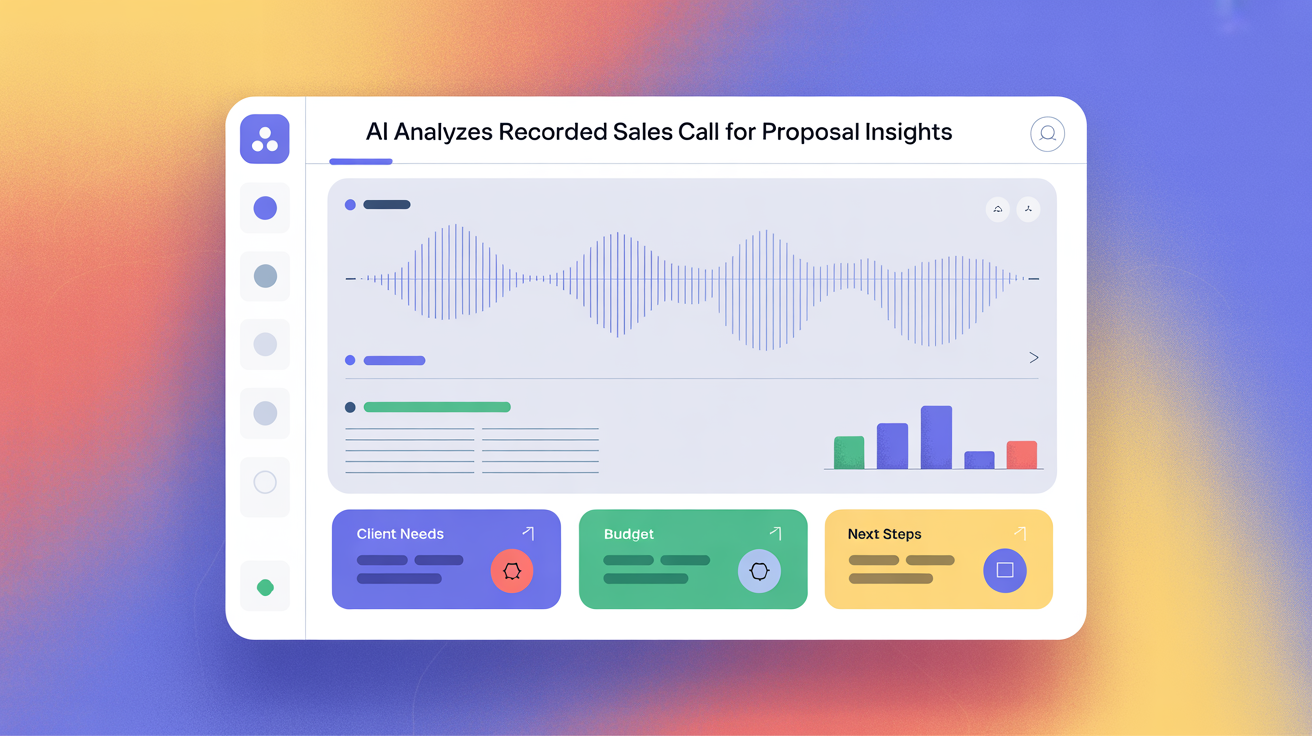Can AI Analyze A Recorded Sales Call To Find What To Include In The Proposal?
AI Tools • Oct 6, 2025 3:41:58 PM • Written by: Kelly Kranz

Yes. AI can transcribe sales calls and extract key customer pain points, commitments, and requirements to inform your proposal content, automating insight extraction from recorded conversations. Use transcription tools to convert the recording to text, then leverage AI to identify critical proposal elements tailored to your buyer personas.
Frequently Asked Questions
Can AI analyze a recorded sales call to find what to include in the proposal?
Yes, AI can transcribe sales calls and extract key customer pain points, commitments, and requirements to inform your proposal content, automating insight extraction from recorded conversations.
What kind of elements can AI systems identify from recorded sales calls?
AI systems can identify customer pain points and priorities, budget discussions, decision-making criteria, technical requirements, and stakeholder concerns from recorded sales calls.
How can AI assist in developing targeted proposals?
AI can help develop targeted proposals by mapping insights from sales call analysis to buyer personas, ensuring the proposal’s language matches communication style and priorities, and validating that the solution positioning addresses the customer's stated concerns.
How AI Transforms Sales Call Analysis
AI-powered sales call analysis represents a fundamental shift from manual note-taking to automated insight extraction. Modern AI systems can process recorded conversations to identify:
- Customer pain points and priorities
- Budget discussions and financial constraints
- Decision-making criteria and timelines
- Technical requirements and specifications
- Stakeholder concerns and objections
This automated analysis ensures no critical details are missed when crafting your proposal.
The Complete AI Sales Call Analysis Process
Step 1: Transcribe the Recording
Use AI transcription services like:
- Otter.ai for detailed conversation capture
- Rev.ai for high-accuracy business transcriptions
- Built-in transcription in platforms like Zoom or Teams
Step 2: Extract Key Proposal Elements
Feed the transcript to AI models (ChatGPT, Claude, or Gemini) with specific prompts:
- "Identify all customer pain points mentioned"
- "Extract budget parameters and financial concerns"
- "List technical requirements and specifications"
- "Highlight decision criteria and evaluation factors"
Step 3: Map Insights to Buyer Personas
This is where The AI Marketing Automation Lab's Buyers Table becomes invaluable. Rather than making assumptions about what resonates with your prospect, you can:
- Test your proposal messaging against their specific buyer persona
- Validate that your solution positioning addresses their stated concerns
- Ensure your language matches their communication style and priorities
- Identify potential objections before they arise
What AI Can Extract for Your Proposals
Customer Requirements Analysis
AI excels at identifying both explicit and implicit requirements from sales conversations:
Explicit Requirements:
- Technical specifications mentioned
- Budget ranges discussed
- Timeline constraints
- Compliance or regulatory needs
Implicit Requirements:
- Underlying concerns about risk
- Unspoken priorities based on question patterns
- Decision-making dynamics between stakeholders
- Success metrics that matter most
Stakeholder Mapping and Concerns
AI can identify different voices in group calls and map their individual concerns:
- Technical stakeholders: Focus on implementation details
- Financial decision-makers: Emphasize ROI and cost considerations
- End users: Highlight ease-of-use and daily impact
- Executives: Stress strategic benefits and competitive advantage
The Buyers Table enhances this analysis by letting you test your proposal sections against each stakeholder type, ensuring your messaging resonates with every decision influencer.
Advanced AI Analysis Techniques
Sentiment and Urgency Detection
Modern AI can assess:
- Enthusiasm levels for different solution components
- Urgency indicators that affect proposal timing
- Concern patterns that require additional addressing
- Confidence levels in moving forward
Competitive Intelligence Extraction
AI can identify:
- Competitor mentions and comparisons
- Previous solution failures or disappointments
- Evaluation criteria that favor your approach
- Pricing expectations based on market references
Objection Anticipation
AI analysis reveals potential objections through:
- Hesitation patterns in the conversation
- Questions about risk or implementation complexity
- Past experience references that suggest concerns
- Stakeholder disagreements or conflicting priorities
Integrating AI Analysis with Proposal Creation
Personalized Messaging Framework
Use AI insights to create proposal sections that directly address:
Opening Executive Summary:
- Lead with the prospect's most critical pain point
- Reference specific challenges mentioned in the call
- Use their language and terminology
Solution Positioning:
- Map features to explicitly stated needs
- Address concerns raised during the conversation
- Highlight benefits that align with their success metrics
Implementation Approach:
- Reference their stated timeline preferences
- Address technical constraints they mentioned
- Include stakeholder considerations from the call
Risk Mitigation Strategies
AI can identify risk concerns to address proactively:
- Budget approval processes discussed
- Technical integration challenges mentioned
- Change management concerns expressed
- Previous vendor relationship issues referenced
The Buyers Table validates your risk mitigation approach by testing how different personas respond to your proposed solutions and timelines.
Maximizing Proposal Win Rates with AI
Before You Write
- Analyze multiple calls with the same prospect for pattern identification
- Cross-reference insights with similar customer profiles
- Validate assumptions using The Buyers Table persona testing
- Identify the most compelling proof points for this specific buyer
During Proposal Development
- Test key messaging with relevant buyer personas
- Validate that your solution positioning addresses the stated concerns
- Ensure technical details match the complexity level they prefer
- Confirm your pricing presentation aligns with their budget discussions
Quality Assurance Check
- Run final sections through The Buyers Table for persona alignment
- Verify all call-derived insights are adequately addressed
- Confirm the proposal structure matches their decision-making process
- Validate that risk concerns have been proactively handled
Implementation Best Practices
Call Recording Optimization
- Inform participants about recording for accuracy purposes
- Use high-quality audio equipment for better transcription results
- Record breakout conversations when stakeholders split into groups
- Capture post-call discussions that often reveal additional insights
AI Analysis Workflow
- Process transcripts within 24 hours while the conversation is fresh
- Use multiple AI models to cross-validate important insights
- Create templates for consistent analysis across sales calls
- Build a database of insights by customer type and industry
Proposal Integration Process
- Create proposal templates based on common customer patterns
- Develop standardized messaging for frequently identified pain points
- Build libraries of case studies and proof points for quick integration
- Establish review processes that verify call insights are addressed
Why The Buyers Table Is Essential for This Process
Traditional sales call analysis relies on the salesperson's interpretation of customer needs. The AI Marketing Automation Lab's Buyers Table adds a critical validation layer:
Assumption Testing
Before finalizing proposal messaging, test your interpretations against buyer personas to ensure:
- Your solution positioning truly resonates
- Technical explanations match their comprehension level
- Risk mitigation strategies address their actual concerns
- Pricing presentation aligns with their decision-making style
Message Optimization
Use The Buyers Table to refine:
- Executive summary language that captures attention
- Technical detail levels appropriate for each stakeholder
- Benefit statements that align with their priorities
- Call-to-action approaches that match their decision-making process
Competitive Differentiation
Validate that your proposal effectively:
- Addresses competitive concerns mentioned in calls
- Positions unique value propositions compellingly
- Responds to evaluation criteria they've shared
- Demonstrates understanding of their specific situation
Measuring Success and Continuous Improvement
Key Performance Indicators
Track improvement in:
- Proposal win rates after implementing AI analysis
- Sales cycle length reduction through better targeting
- Follow-up meeting conversion rates
- Stakeholder engagement levels with proposals
Feedback Integration
- Collect win/loss feedback to refine AI analysis prompts
- Update Buyers Table personas based on successful proposals
- Document which insights lead to the highest win rates
- Build predictive models for proposal success probability
Process Refinement
- Continuously improve by A/B testing different AI analysis approaches
- Refining transcription accuracy through better recording practices
- Updating proposal templates based on successful patterns
- Training team members on effective AI prompt engineering
The combination of AI sales call analysis and The Buyers Table creates a systematic approach to proposal development that removes guesswork and dramatically improves win rates. By understanding exactly what prospects need and validating your response with AI-powered buyer personas, you can craft proposals that speak directly to their priorities and concerns.
This data-driven approach to proposal creation represents the future of B2B sales, where every customer interaction is captured, analyzed, and leveraged for maximum competitive advantage.
Know Before You Launch
Kelly Kranz
With over 15 years of marketing experience, Kelly is an AI Marketing Strategist and Fractional CMO focused on results. She is renowned for building data-driven marketing systems that simplify workloads and drive growth. Her award-winning expertise in marketing automation once generated $2.1 million in additional revenue for a client in under a year. Kelly writes to help businesses work smarter and build for a sustainable future.

